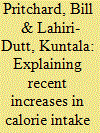|
|
|
Sort Order |
|
|
|
Items / Page
|
|
|
|
|
|
|
| Srl | Item |
| 1 |
ID:
165089


|
|
|
|
|
| Summary/Abstract |
During the past decade, considerable research efforts have sought to explain India’s “calorie consumption paradox”, namely, the coexistence of a decline in average per capita calorie intake in rural India alongside increased material living standards. Evidence from the most recent (68th) round of the National Sample Survey (NSS), released in 2014, however, indicates increases in calorie intake, notably among poorer income quintiles. This paper argues that the turnaround in these data is linked to the improved performance of pro-poor social protection measures. Analysis of data suggests a close association between states that have made the greatest improvements in social policy delivery systems, and increased calorie intake for the poorest quintile of rural populations. This conclusion supports wider international evidence on the importance of social protection strengthening for nutrition-sensitive economic growth.
|
|
|
|
|
|
|
|
|
|
|
|
|
|
|
|
| 2 |
ID:
165088


|
|
|
|
|
| Summary/Abstract |
India’s government under Narendra Modi represents a return to single party rule. This paper investigates whether and why single party governments in India differ in their extremity of foreign policies from coalition governments. It particularly focuses on how different forms of government influence the saliency, contestation, and enactment of national conceptions about India’s global role. First, I situate India within the academic debate regarding coalitional governments and foreign policy. I suggest that one reason why India challenges scholars‘ assumption is the missing link between partisan conceptions of India’s global role and their institutional representation. Second, I propose a role theoretical approach and argue that the process of self-identification, consisting of ego and anticipated alter expectations, conditions a state’s role set and extreme foreign policy. It is hypothesized that the nature of contestation of national role conceptions varies between factions and fractions because of the nature of India’s party system, as well as the relative significance of external others for India’s identity. Third, I examine instances of role-taking in the field of nuclearization and Sino-Indian relations. Findings suggest that contested role conceptions during single-party rule caused more extreme variances in international role-taking, while coalition governments proved to induce more complementary role-taking processes.
|
|
|
|
|
|
|
|
|
|
|
|
|
|
|
|
| 3 |
ID:
165090


|
|
|
|
|
| Summary/Abstract |
Elections bestow popular legitimacy to the democracies and, accordingly, electoral participation is an important indicator of the quality of democracy and civic engagement. Understanding what factors drive citizens’ decision to vote is central to the theory and practice of democracy and has implications for voter mobilization efforts of political parties and government agencies. We study the individual level determinants of electoral turnout in the 2004 Lok Sabha elections exploiting a nationally representative India Human Development Survey-2005 (IHDS-2005). We find convincing yet mixed evidence in support of political-institutional factors, and some variables of the psychological, mobilization, socialization, and resource models in explaining voter turnout. Public confidence in state government, newspapers, and judiciary, television watching, participation in civic body meetings, local conflict, caste conflict in neighborhood, local political connections, and caste association membership significantly increase the predicted probability of turnout. Factors like time family lived in the place, age, holding of below-poverty-line (BPL) cards, and receipt of public benefits increase voter turnout; whereas, business association membership, being female, metro-city resident, business being the main income source, urban residence, and the age quadratic reduce voter turnout. Separate analyses of the rural and urban, male and female contexts largely obtain the same line of results.
|
|
|
|
|
|
|
|
|
|
|
|
|
|
|
|
|
|
|
|
|